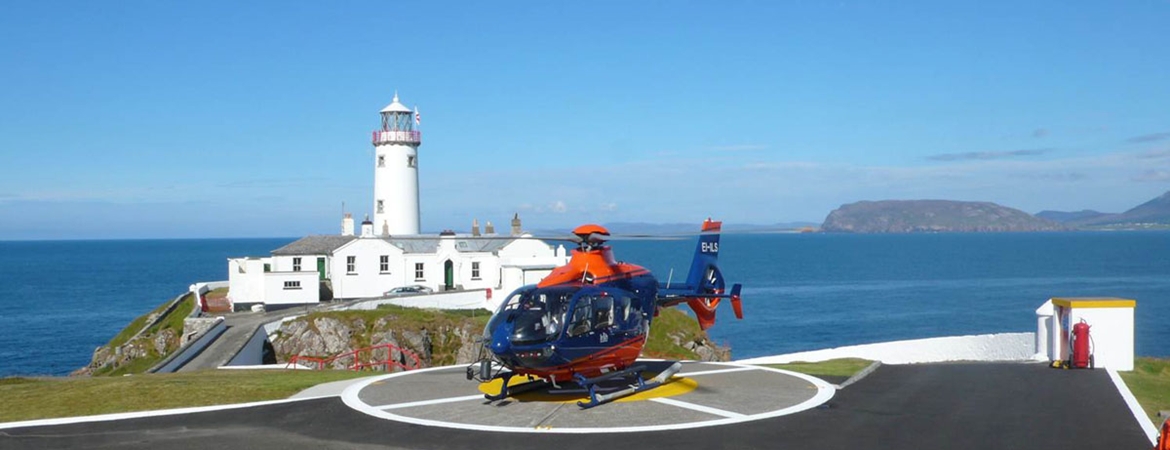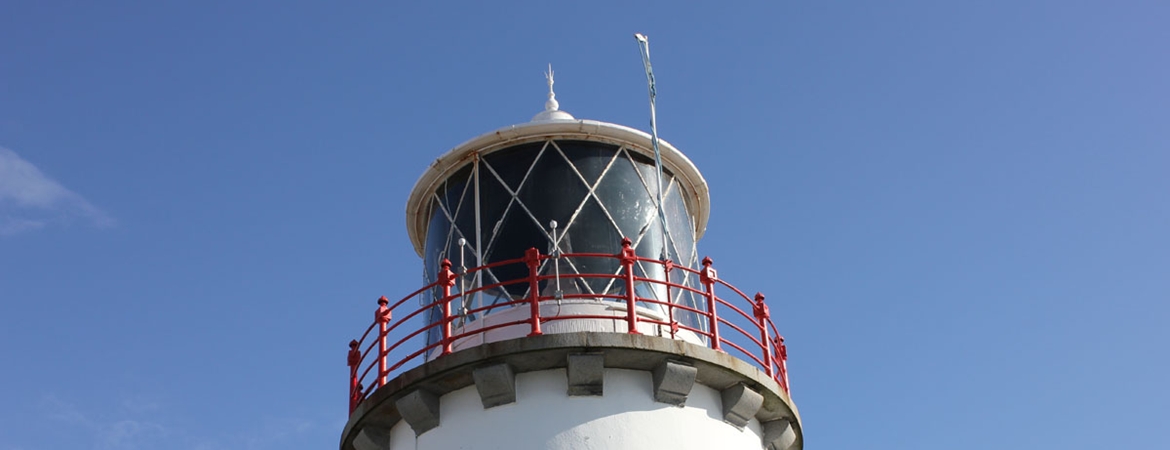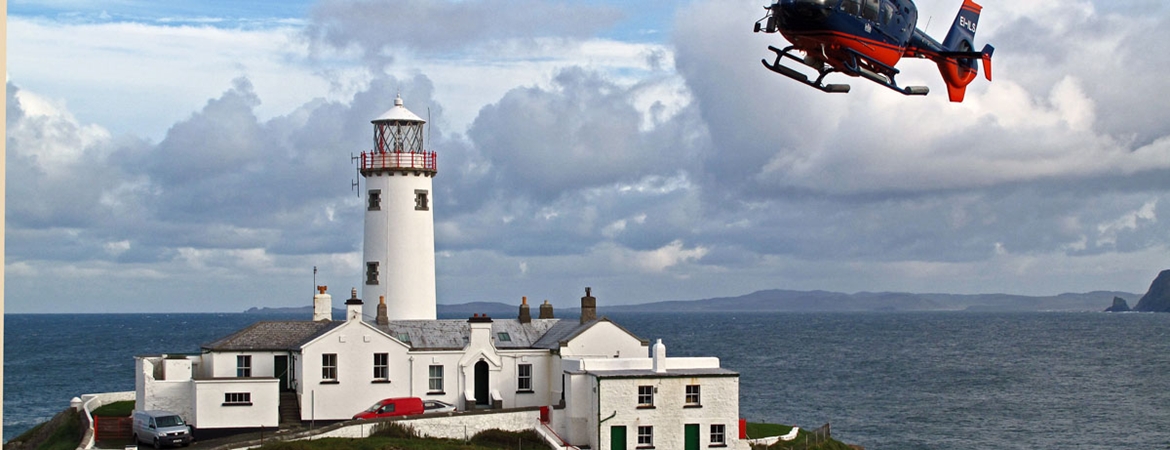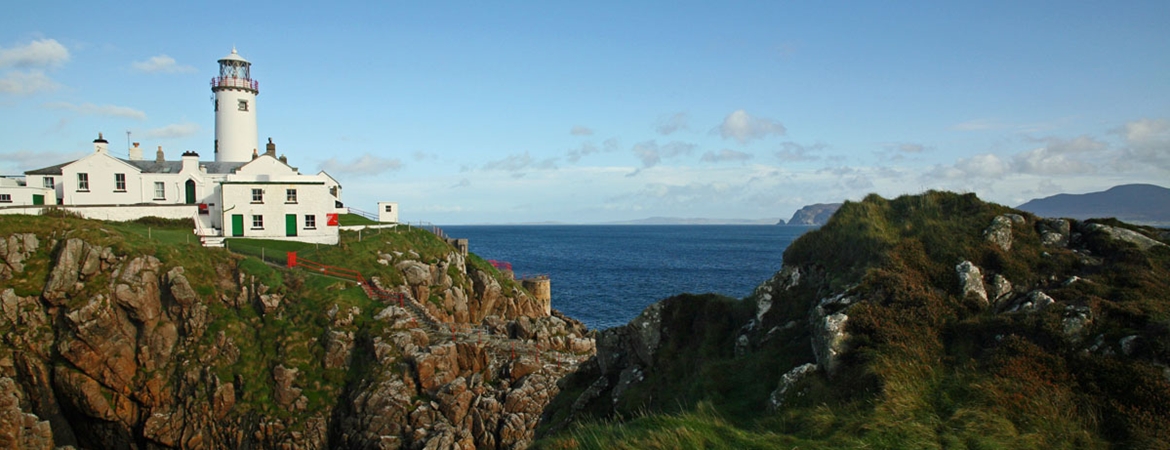 |
Fanad Head Lighthouse is one of 70 lighthouses operated by the Commissioners of Irish Lights around the coast of Ireland and plays a vital role in maritime safety. It is also one of twelve lighthouses which make up Great Lighthouses of Ireland, a new all-island tourism initiative. Visitors from home and abroad now have the chance to visit or stay in a lighthouse and to find out about our history and heritage, to appreciate the spectacular natural world around us, to discover the technology at work today and to engage with our coastal communities. With aspects to appeal to people of all ages and interests, Great Lighthouses of Ireland offers memorable and enriching experiences and creates appreciation of the role of lighthouses past, present and into the future. To find out more about Great Lighthouses of Ireland click here |
History
This light is classified as a sea light as distinct from a harbour light although it does mark the entrance into Lough Swilly which forms a natural harbour of refuge.
In 1812 the frigate Saldana was wrecked on Fannet Point, as it was called then, and became a total loss except for the ship's parrot which bore a silver collar inscribed Saldana. Soon after the loss of this vessel Captain Hill of the Royal Navy in Derry, whose experience of the north-west coast from Blacksod to Lough Foyle was second to none, wrote to one of the members of the Corporation for Preserving and Improving the Port of Dublin (the Ballast Board) suggesting that a lighthouse should be placed on Fannet Point. He also backed up his request by stating that the Saldana would not have been lost if there had been a light on Fannet.
Without question the Board approved Captain Hill's request and they approached Trinity House, who gave their sanction in July 1814.
The Admiralty Signal Tower on Fannet was taken over ostensibly to be used as a Keeper's dwelling and also to prevent local inhabitants dismantling it for their own devices but it seems to have been taken down and used by the Corporation when the lighthouse and dwellings were built. These were designed by the Board's Inspector of Works & Inspector of Lighthouses, George Halpin. The first lighthouse was similar in size to two other towers being built around the same time, one at Mutton Island off Salthill, Galway Bay, and the other at Roche's Point on the eastern entrance to Cork harbour. They were 5 feet 9 inches inside diameter by three stories high-ground, first floor and lantern.
(Roche's Point was subsequently replaced by a larger 11 foot 6 inch diameter tower; the original small tower was taken down and rebuilt at Blackhead, north-east of Duncannon Fort on the east side of the entrance into Waterford Harbour to form a leading light with the already established light at the Fort. The Fort light became the front light and the Blackhead light became the rear or North Duncannon light.)
The Deed of Conveyance for the property at Fanad Head was signed and the money paid to Lord Leitrim in Leitrim in April 1818 in accordance with the Inquisition dated October 1814.
Fannet Point Lighthouse was first lit on 17 March 1817. Its fixed or non-flashing catoptric light showed red to sea and white towards the Lough, and could be seen for fourteen miles in clear weather. The optic consisted of nine Argand sperm oil wick lamps and parabolic reflectors. The seaward lamps would have had red coloured lamp glasses.
One of the first requests for better lighting in the immediate vicinity of Lough Swilly came from the Duke of Abercorn backed up by numerous signatories in a memorial dated March 1871. The request was referred to Trinity House who inspected the area in 1872 and in their report recommended Fanad Head to be converted to a second order dioptric fixed lens with a red sector over the Swilly Rocks. They also agreed that lights should be established at Dunree Head and Buncrana Pier. Work went ahead on both these lights and they were established on 15th January 1876.
Fanad was slower in its change over. During 1875 the Board's Engineer, Mr Sloane, estimated for improvements at Fanad together with a light to mark the Limeburner Rock. Then in 1876 gas was suggested instead of colza or rape seed oil. This would have meant the construction of a gas works similar to Tory Island and certain other rock and mainland stations. Trinity House made yet another recommendation in 1877, this time that Tory Island be altered to a first order group flashing light and the old Tory Island lens to be fitted into a new tower built at Fanad with a sectional light to show from the base of the tower over the Limeburner Rock. Still nothing was done until 1880 when the Inspecting Committee recommended adopting the Engineer's and Inspector's report (Mr W. Douglass and Captain Cole) for an occulting second order light using paraffin showing white with a red sector over the Swilly Rocks and a lower white sector light over the Limeburner Rock. Construction went ahead and a new larger and higher tower, close to the original tower was built together with an extra dwelling. In both cases a connecting corridor joined the tower to the dwelling. The new lights went into operation on 1 September 1886, the main light was occulting white and red every thirty seconds with its fixed catadioptric second order lens and circular occulting screen around the burner turned by a small clockwork rotation machine which gave a character of 30 seconds. An auxiliary fixed white light in one of the windows at the base of the tower shone over the Limeburner Rock. The character of this light was changed in August 1932 to one white flash every 3 seconds (fl 0.33, ec 2.66) visible from 102? to 112? over Limeburner Rock.
In August 1906 the Board's Engineer, Mr C.W. Scott, presented an estimate to the Board to change the light to group flashing with an incandescent paraffin burner. Trinity House modified the proposed character so as not to be confused with Tory Island. On 12 August 1909 the new revolving third order 500mm focal distance lens turned by a weight driven clockwork rotation machine together with a vaporised paraffin mantle burner was exhibited giving a character of six flashes every fifteen seconds and increased candle power.
Fanad Head Lighthouse was struck by lightning on the night of the 20-21 December 1916. The Principal Keeper reported the incident to the Inspector, Captain Deane who, in his report to the Board, submitted extracts from the rules of the Lightning Research Commission of the Royal Institute of British Architects for the erection of lightning conductors as none of our stations were properly protected. He also suggested contacting Trinity House and the Northern Lighthouse Board.
The following week the Board's Engineer, Mr C.W. Scott, stated that the Commissioners conformed to the rules and that it was not necessary to contact Trinity House or the Northern Lights; in any case the damage to the station was very small. The Board approved the Engineer's report.
Perhaps one of the most revolutionary changes to occur in the Lighthouse Service happened towards the end of 1969 when helicopters were introduced to effect the reliefs of rock stations from Fastnet in the south west to Inishtrahull on the north coast. Fanad Head was chosen as the land base for Tory Island and Inishtrahull.
The 1906 apparatus was completely replaced in 1975 when the light was converted to unwatched electric, that is the night watch was discontinued and the light character altered from Group Flashing six white and red 15 seconds to Group Flashing five white and red 20 seconds and the nominal range of the auxiliary light was increased to 15 nautical miles. The Auxiliary light over the Limeburner Rock was discontinued in 1977 being replaced by another red sector in the main light, the other red sector is over the Swilly Rocks. The light is a 300mm catadioptric cylindrical refractor with electric L24 1.5kW lamps in a UVLA40 lampchanger.
Early in 1978 the Assistant Keeper was transferred making the station a Principal Keeper station. On the retirement of the Principal Keeper on 30th September 1983 the station was re-classified as an Attendant station.









